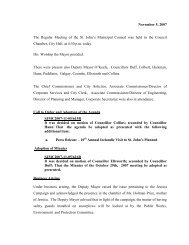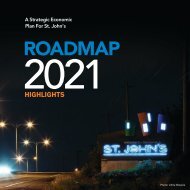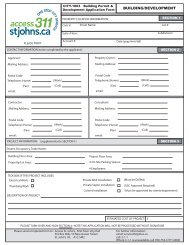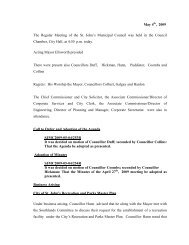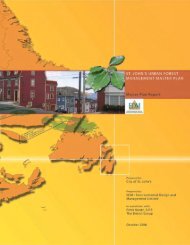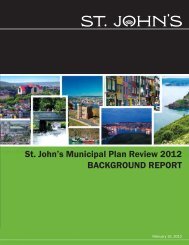Metrobus Transit Study.pdf - City of St. John's
Metrobus Transit Study.pdf - City of St. John's
Metrobus Transit Study.pdf - City of St. John's
Create successful ePaper yourself
Turn your PDF publications into a flip-book with our unique Google optimized e-Paper software.
<strong>St</strong>. John’s Transportation Commission (<strong>Metrobus</strong>) 2011<br />
Market Assessment and <strong>St</strong>rategic Directions <strong><strong>St</strong>udy</strong> – Part B: The Past and Present – Understanding Ridership Trends<br />
occurred in <strong>St</strong>. John’s has been low density and not transit supportive. Mount Pearl is almost fully<br />
built out with only 4 percent <strong>of</strong> land zoned residential available for future development<br />
(Unpublished Newfoundland and Labrador Department <strong>of</strong> Municipal Affairs Report, 2009).<br />
<strong>St</strong>. John’s is also proposing to amend the Regional Policy Plan to allow for development above the<br />
190 metres contour elevation. Removal <strong>of</strong> this policy restriction would open up an additional 290<br />
hectares <strong>of</strong> developable land in the Southlands area and 200 hectares in the Southwest Development<br />
Area. A recent review <strong>of</strong> the <strong>St</strong>. John’s Agricultural Development Area by the Provincial<br />
government is also recommending that 567 hectares <strong>of</strong> agricultural land be made available for urban<br />
development, including 443 hectares in Portugal Cove – <strong>St</strong>. Philip’s near Windsor Lake<br />
(Newfoundland and Labrador Department <strong>of</strong> Natural Resources, 2009).<br />
Residential expansion is expected to continue in the rapidly growing Town <strong>of</strong> Paradise. Major<br />
growth is anticipated around Adams Pond and adjacent to Octagon Pond. Development is<br />
comprised <strong>of</strong> large lot, low density districts with local commercial uses. However, land is set aside<br />
for higher density development and will be developed according to market conditions. Overall,<br />
almost 6,000 residential units are expected in Paradise, while almost 5,000 residential units are<br />
expected in Conception Bay South. Big box retail development (40 hectares) and light industrial use<br />
(16 hectares) are also expected in Conception Bay South. (Unpublished Newfoundland and<br />
Labrador Department <strong>of</strong> Municipal Affairs Report, 2009).<br />
Overall, there is a general oversupply <strong>of</strong> land planned for and potentially available for residential<br />
development even though most (75 percent) residential development is expected to be single<br />
detached. There is, however, a need for more employment uses and a new business park in the range<br />
<strong>of</strong> 200 hectares (Unpublished Newfoundland and Labrador Department <strong>of</strong> Municipal Affairs<br />
Report, 2009).<br />
To address overall servicing needs, many provinces in Canada have developed growth plans to guide<br />
Official / Development Plans in each municipality. In Ontario, the provincial government<br />
developed a ‘Places to Grow’ growth plan. One <strong>of</strong> the keys to this plan is a 40 percent<br />
intensification target. This means that all municipalities must ensure that 40 percent <strong>of</strong> new<br />
development occurs in existing built-up areas (intensification) as opposed to greenfield<br />
development. This initiative helps support the effective delivery <strong>of</strong> services, including transit.<br />
Public transit service should be proactive in servicing future development areas. Most <strong>of</strong> the areas<br />
identified for development in <strong>St</strong>. John’s are currently served by transit, however coverage and service<br />
levels may need to be increased. Paradise currently does not have transit service, and a previous<br />
transit study commissioned by the Town identified some need for service but concluded that if<br />
would not be cost effective. Clearly, a regional transit strategy will be required to address ridership<br />
growth opportunities in the greater <strong>St</strong>. John’s area.<br />
6.4 Demographic Characteristics<br />
Aging Population<br />
<strong>St</strong>. John’s population pr<strong>of</strong>ile has been aging over the past 20 years. Levels <strong>of</strong> natural population<br />
increase in the region are declining due to decreasing fertility rates, the aging <strong>of</strong> the population<br />
overall, and particularly the aging <strong>of</strong> the “baby boomers” beyond the childbearing years.<br />
It is important to understand that the amount and type <strong>of</strong> housing occurring in the region is directly<br />
dependent on the age structure. An older population is generally characterized by smaller<br />
households as “empty nesters” are formed when the <strong>of</strong>fspring move out. Labour force participation<br />
Dillon Consulting Limited Page 34






